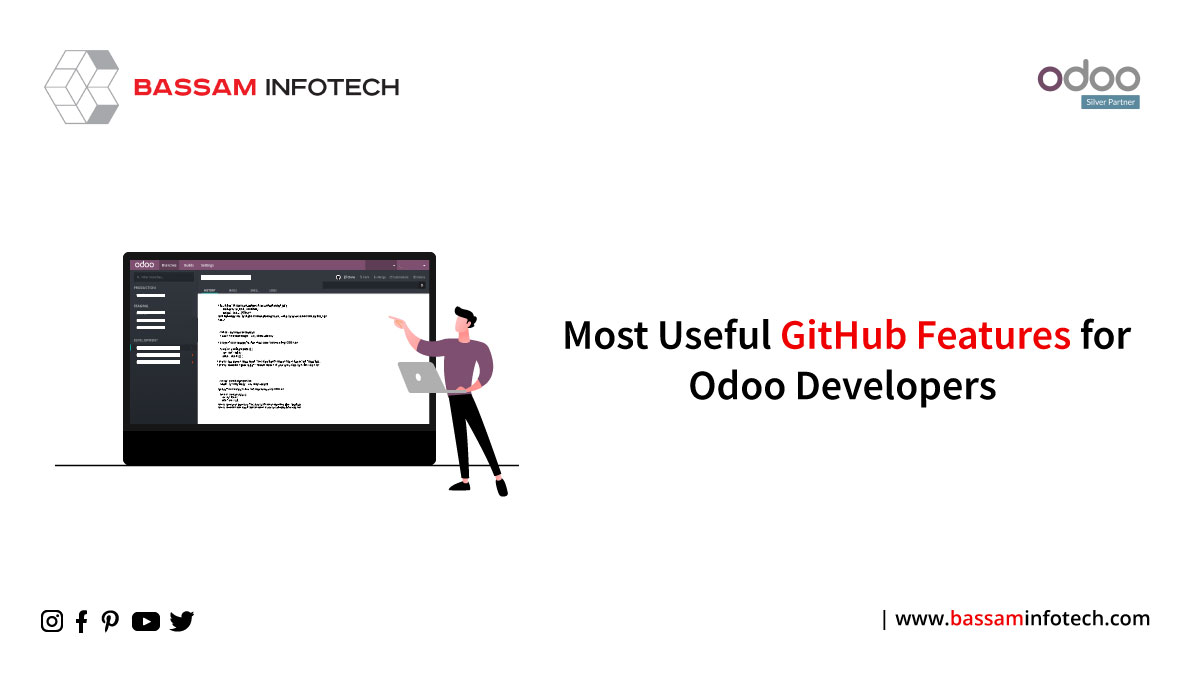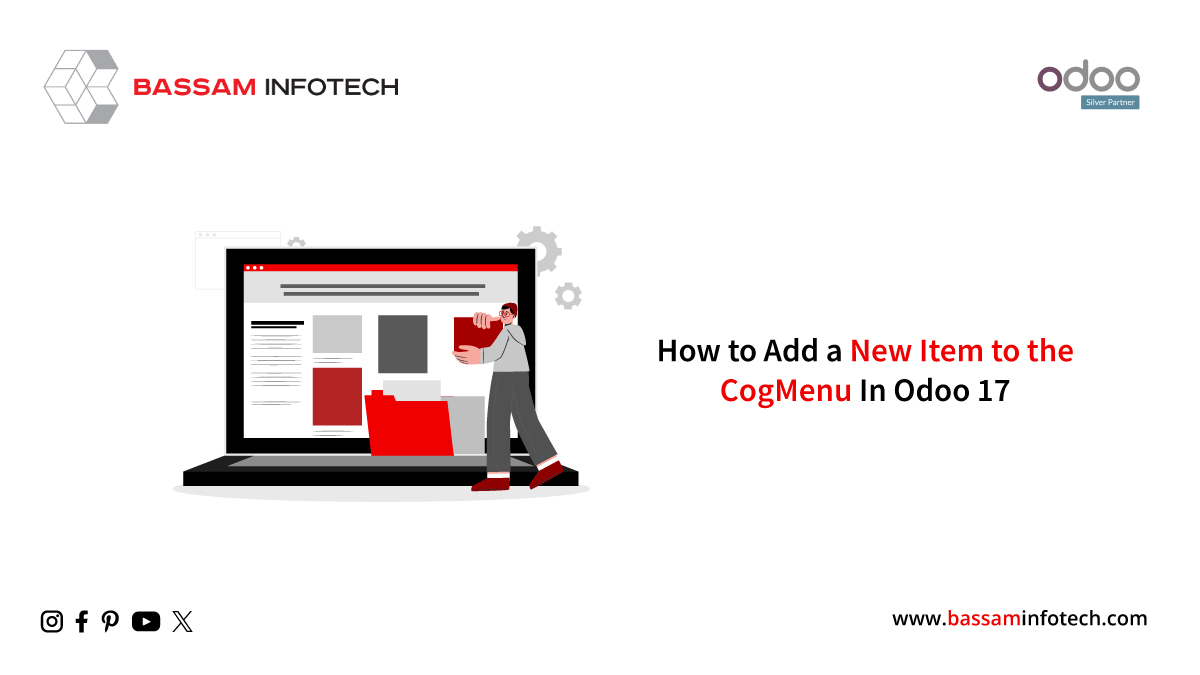GitHub Features for Odoo 16 Developers

GitHub is a High-rated programming resource for storing and sharing programming code, and GitHub is a networking social website for different programmers. GitHub is an up-and-coming social network for project management and collaboration by companies, organizations, and individuals. And GitHub gives different features that can be very helpful for all programmers and GitHub allows desktop software that can integrate with GitHub.
GitHub specifications are beneficial for Odoo developers.
Different Features of GitHub and How We Can Make It Useful
GitHub Mobile:
GitHub mobile is a mobile app available on both iOS and android. Which is simple to use and works quickly and from anywhere. It is secure and safe. We can accept the data through a secured, first-party client application and we can monitor and clear messages using GitHub mobile application. We can collaborate, create pull requests, read, and review and we can search and communicate with different users, different organizations, and different repositories. If someone mentions your name in GitHub, you will get alerts. protect our account using two-factor authentication in GitHub. Verify our sign-in attempts from unrecognized devices.
Both the GitHub business server and mobile devices can sign in to GitHub at the same time. Without a third-party service, which can have a delay, the GitHub enterprise server supports notifications. VPN is required for GitHub mobile work with businesses. On the GitHub business server, we can log in via a mobile device. We can see the newly created enterprise account inside the profile. Then, we must include the specifics. After that, we can change between the two accounts. We can sign out of the enterprise server if we don’t wish to use our personal account to access the data through an enterprise account.
There are several languages that GitHub mobile supports, including English, Japanese, Brazilian Portuguese, Simplified Chinese, and Spanish. If the language is configured, it becomes the default language, and Spanish. When we configure a language, it becomes the default language until we choose another one in the settings. When we click on the link in GitHub, GitHub mobile opens in its place, not Safari. If we disable the universal link, a safari-style redirect will take its place. Re-enabling is also a possibility.
Actions:
Continuous integration and continuous delivery (CI/CD) is a GitHub action that enables build, test, and deployment automation. The workflows can be created and tested. Pull requests can be written to the repository and merged into production. GitHub actions are choreographed workflows based on any event, which controls how they are executed, how feedback is given, and how every workflow stage is secured. Actions support more languages and frameworks than in the past, including Java, PHP, Node.js, Python, Ruby, C/C++, NET, iOS, and Android. Docker-compose can be used in our file workflow to test how well a web service and its database function together.
jobs:
test:
name: Test on node ${{ matrix.node_version }} and ${{ matrix.os }}
runs-on: ${{ matrix.os }}
strategy:
matrix:
node_version: [8, 10, 12]
os: [ubuntu-latest, windows-latest, macos-latest]
steps:
- uses: actions/checkout@v1
- name: Use Node.js ${{ matrix.node_version }}
uses: actions/setup-node@v1
with:
version: ${{ matrix.node_version }}
- name: npm install, build and test
run: |
npm install
npm run build --if-present
npm test
Live logs offer in-the-moment feedback, and GitHub streams record the actions, providing a real-time status update. These logs are simple to read and also contain emojis. We can create a deep link in a log file, and a straightforward permalink can make it simple to talk to a friend about a build failure. The actions and workflows can be written and reused. We can edit, distribute, reuse, and fork the code we are using because GitHub activities also contain code. We could change our actions to meet our own needs. The workflows are based on YAML, and Action always uses a new syntax. The repository reference actions can be reused.
Code space:
We can build a codespace from a repository of template files and then investigate some of the key capabilities it offers. We must first access a template repository and choose to employ this template in order to create a code space. And we must enter the repository’s name, select the privacy setting, and then click Create the repository from the template. And we can choose the repository’s owner at this point. It sends you to the new repository’s home page. We can see the create code space button on the main tab and the code dropdown menu under the repository’s name.
Once our code space is created, then the repo will automatically clone to it. We can run the application and run it in the browser. We can enter the command npm start, this example uses nodejs project, this command starts in the package.json. The web application will define in the sample repository. We can follow different applications, we can type the corresponding start command for each project. When we start an application, the codespace recognizes the ports the application is running and shows for informing it forwarded. You can click the open browser to see the running application in a new tab. You can edit the application, you can see the changes. And you can commit and push your changes.
Copilot:
Developers often struggle with how to write efficient code. With copilot, they can quickly generate code snippets that make sense. GitHub Features added automatic code-generating tools, which is one the newest tools, and branded an AI pair programmer. It is not just an autocorrect solution, which is based on the clues from the code that we are writing. It also suggests lines sometimes even the complete functions can also suggest. It’s the fastest way for developers to create tests, explore APIs, etc.
If we start work with the copilot feature the tool can automatically adapt to the way we write codes. Copilot powered by the open codex, wish is an auto-generated suggestion from the file, such as the name of functions, comment of codes, names of files, the position of the mouse, and so forth Based on the information, copilot provides code snippets, which can be accepted by pressing a tab key. AI tools to understand languages are TypeScript, ruby, Dozen and Python, and other common languages as well.
These suggestions are coming from the Open Source Code within the repositories of GitHub.They always try to find the Best Solution. GitHub copilot is an Artificial Intelligence Tool. It is Free for Verified Students and Source Maintainers. If we are not in these Two Categories, then we can use it for 6 Months of Trial. After the Trial, we have to use a Subscription. We have an Option to Select GitHub Pilot in Settings. We Enable the Enable GitHub Pilot Button. Then we can Select Continue to Get Access to the Copilot and then Submit.
Packages:
The GitHub package feature is a platform for hosting and managing packages, including containers and dependencies. It integrates our source codes and other repositories which are in one place, providing integrated permission management and billing, so we centralize our software developments. We can integrate these repositories with the APIs, actions, and webhooks, creating an end-to-end development workflow, including our codes, CI, and deployment solutions. This package provides different package registries also, commonly used packages being npm, Ruby gems, Apache maven, Gradle, Docker, and NuGet. Packages permissions is a package inherited by the repository for packages hosted, or packages in the container repository. We can publish packages publicly or privately. Public package usage is completely free, with private packages we have a certain amount of free storage and data transfer, depending on the products we use. Usage includes quantities controlled by spending limits.
Security:
GitHub security Features help us keep our code secret and safe in repositories in all organizations, including private ones. Some features are available to all repositories, but additional ones are available only in enterprise versions. Advanced security is enabled in all repositories. Security policy allows us to confidentially report security issues. Privately we can talk about them and fix them, then we can publish an advisory. Dependent alerts for updates depend on when pull requests are generated. If we’re using dependable, which automates raising pull requests that keep dependencies updated, we can use it to make sure they stay up to date.
A dependency graph shows us how our ecosystem works. GitHub offers advanced security features that are free. Companies can use the GitHub Enterprise Cloud License for its advanced security. Code scanning finds potential security flaws and coding errors. They highlight problems. We can correct them before merging. Which automatically identifies the leaked secrets that show complete changes to dependencies and lets us know what happened.
Code review:
We can decrease noise by limiting notifications when a team reviews a pull request. To do so, we must clarify the individual responsibility of pull request reviews. By configuring code review settings, we can limit notifications for specific teams and assign them automatically. For example, we can disable notifications for a team and then assign a pull request to a single member of the team. Or, we can assign a pull request to an entire team and then disable notifications for that team.
DOWNLOAD ERP
"Unlock the Full Potential of Your Business with Odoo ERP!"
"Get a Cost Estimate for Your ERP Project, Absolutely FREE!"
Get a Free Quote


